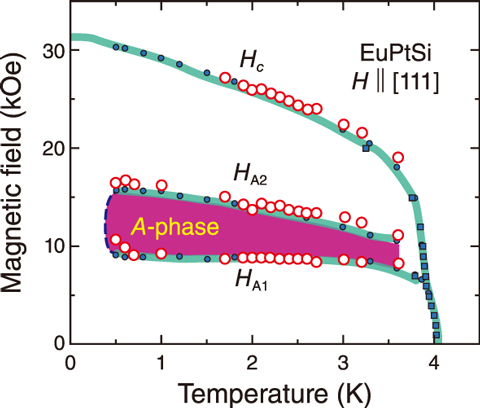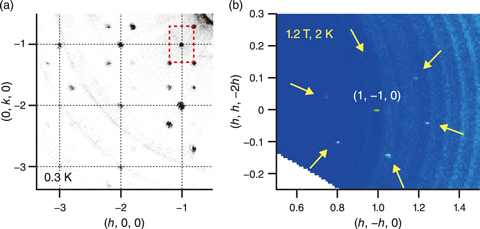
Fig.5-13 Magnetic phase diagram of EuPtSi

Fig.5-14 Neutron scattering intensity map of EuPtSi (a) at zero field, (b) 1.2 T
Magnetic skyrmions are particle-like, topologically non-trivial spin textures that have attracted interest in fundamental aspects as well as applications due to their potential as a low-power-consumption device. A magnetic skyrmion formation was first identified in a chiral magnet MnSi. This discovery has triggered an intensive search for compounds with similar crystal structures, leading to the discovery of their existence in MnGe, FeGe, and insulator Cu2OSeO3. A variety of characteristic properties have been unveiled as the number of skyrmion compounds has increased. Unlike this diversity, magnetic ions have been mostly limited to 3d transition metal elements.
Recently, high-quality single crystals of the 4ƒ electron compound EuPtSi have been grown to have a similar crystal structure. In EuPtSi, seven 4ƒ electrons carry magnetism. This compound exhibits an antiferromagnetic transition at 4 K at a zero magnetic field. Characteristic features emerged under magnetic fields, including a field-induced phase, i.e., the A phase, which appeared only at a finite temperature and magnetic field, as shown in Fig.5-13. This feature, common to the skyrmion phase of MnSi, implies the existence of a magnetic skyrmion in EuPtSi. To clarify the nature of the A phase, single-crystal neutron diffraction experiments were carried out under a magnetic field.
Neutron diffraction is a powerful probe to determine the spin arrangement under an extreme environment, such as low temperature and a magnetic field. Experiments were performed using the Wide-Angle Neutron Diffractometer (WAND2) installed at the High Flux Isotope Reactor (HFIR) in Oak Ridge National Laboratory (ORNL), U.S.A. and SENJU located at BL18 in the Materials Life Science Facility (MLF), J-PARC.
The formation of a magnetic skyrmion lattice in MnSi was evidenced by small-angle neutron scattering via an observation of six-fold magnetic diffraction patterns in the plane normal to the applied field. In EuPtSi, the magnetic structure at a zero field was helical, characterized by a rectangular form as displayed in Fig.5-14. By applying a magnetic field, the diffraction pattern exhibited substantial change when the system enters the A phase; the rectangular pattern at the zero field changed into a six-fold pattern in the plane normal to the field. Thus, the pattern common to the skyrmion phase was demonstrated.
This work revealed that magnetic diffraction pattern of EuPtSi has similar characteristics to the archetypical skyrmion lattice magnet MnSi, suggesting a formation of skyrmion lattice in EuPtSi. However, marked differences were seen. The periodicity in MnSi is quite long, requiring small-angle neutron scattering to separate magnetic and nuclear peaks, whereas the standard diffraction is sufficient to reveal magnetic patterns in EuPtSi owing to its shorter periodic length: 18 versus 1.8 nm in MnSi and EuPtSi, respectively. In addition, the A phase in EuPtSi was stabilized over a relatively wide temperature range, whereas that of MnSi exists over only a narrow region in close proximity to the transition temperature. Overall, the discovery of a magnetic skyrmion phase in 4ƒ electron systems has provided a new direction to explore another compounds and has unveiled more characteristics of skyrmions.
This work was performed under the US-Japan Cooperative Program on Neutron Scattering, and supported by the Japan Society for the Promotion of Science (JSPS) KAKENHI Grant-in-Aid for Scientific Research (C) (No.16K05031).